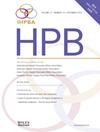Update to the role of staging laparoscopy in the assessment of resectability of perihilar cholangiocarcinoma: have improvements in cross-sectional and functional imaging rendered it redundant?
IF 2.4
3区 医学
Q2 GASTROENTEROLOGY & HEPATOLOGY
引用次数: 0
Abstract
Introduction
Perihilar cholangiocarcinoma has poor prognosis. Accurate staging is paramount in stratifying patients to appropriate treatment: curative surgery or palliative systemic anti-cancer therapy. Conventional CT and MRI are insufficiently sensitive at identifying peritoneal or liver metastases. Since 2020, [18F]fluorodeoxyglucose positron emission tomography-computerised tomography (FDG PET-CT) has been incorporated into staging, prompting reassessment of staging laparoscopy's role in determining resectability.
Methods
This retrospective study reviewed patients referred with suspected perihilar cholangiocarcinoma to a UK hepatobiliary centre between 2020 and 2024 (n = 304). Those with potentially resectable disease on conventional CT and MRI were compared to a matched 2016–2019 cohort (n = 57).
Results
Between 2020 and 2024, CT and MRI identified inoperable disease in 248/304 patients. FDG PET-CT further excluded 16/56 patients. Staging laparoscopy in 40 patients excluded 5. Among 35 proceeding to laparotomy, 33 completed curative-intent resection. In 2016–2019, all 57 underwent staging laparoscopy, excluding 9. Of 48 proceeding to laparotomy, 40 completed resection.
Conclusions
Advances in cross-sectional imaging, including FDG PET-CT, have improved radiological staging. However, at 1-in-8, the diagnostic yield of staging laparoscopy remains high, justifying its continued role in evaluating resectability.
腹腔镜分期在评估肝门周围胆管癌可切除性中的作用的最新进展:横断面和功能成像的改进是否使其变得多余?
肝门周围胆管癌预后差。准确的分期是最重要的分层患者适当的治疗:根治性手术或姑息性全身抗癌治疗。传统的CT和MRI在鉴别腹膜或肝脏转移方面不够敏感。自2020年以来,[18F]氟脱氧葡萄糖正电子发射断层扫描-计算机断层扫描(FDG PET-CT)已被纳入分期,促使人们重新评估腹腔镜分期在确定可切除性中的作用。方法:这项回顾性研究回顾了2020年至2024年期间在英国肝胆中心转诊的疑似肝门周围胆管癌患者(n = 304)。在常规CT和MRI上有可能切除疾病的患者与匹配的2016-2019年队列(n = 57)进行比较。结果:在2020年至2024年期间,CT和MRI在248/304例患者中发现了无法手术的疾病。FDG PET-CT进一步排除了16/56例患者。腹腔镜分期40例,排除5例。在35例开腹手术中,33例完成了治疗目的切除。2016-2019年,除9例外,所有57例患者均进行了分期腹腔镜检查。48例进行剖腹手术,40例完成手术切除。结论:横断成像技术的进步,包括FDG PET-CT,改善了放射分期。然而,分期腹腔镜的诊断率为1 / 8,仍然很高,证明了其在评估可切除性方面的继续作用。
本文章由计算机程序翻译,如有差异,请以英文原文为准。
求助全文
约1分钟内获得全文
求助全文
来源期刊

Hpb
GASTROENTEROLOGY & HEPATOLOGY-SURGERY
CiteScore
5.60
自引率
3.40%
发文量
244
审稿时长
57 days
期刊介绍:
HPB is an international forum for clinical, scientific and educational communication.
Twelve issues a year bring the reader leading articles, expert reviews, original articles, images, editorials, and reader correspondence encompassing all aspects of benign and malignant hepatobiliary disease and its management. HPB features relevant aspects of clinical and translational research and practice.
Specific areas of interest include HPB diseases encountered globally by clinical practitioners in this specialist field of gastrointestinal surgery. The journal addresses the challenges faced in the management of cancer involving the liver, biliary system and pancreas. While surgical oncology represents a large part of HPB practice, submission of manuscripts relating to liver and pancreas transplantation, the treatment of benign conditions such as acute and chronic pancreatitis, and those relating to hepatobiliary infection and inflammation are also welcomed. There will be a focus on developing a multidisciplinary approach to diagnosis and treatment with endoscopic and laparoscopic approaches, radiological interventions and surgical techniques being strongly represented. HPB welcomes submission of manuscripts in all these areas and in scientific focused research that has clear clinical relevance to HPB surgical practice.
HPB aims to help its readers - surgeons, physicians, radiologists and basic scientists - to develop their knowledge and practice. HPB will be of interest to specialists involved in the management of hepatobiliary and pancreatic disease however will also inform those working in related fields.
Abstracted and Indexed in:
MEDLINE®
EMBASE
PubMed
Science Citation Index Expanded
Academic Search (EBSCO)
HPB is owned by the International Hepato-Pancreato-Biliary Association (IHPBA) and is also the official Journal of the American Hepato-Pancreato-Biliary Association (AHPBA), the Asian-Pacific Hepato Pancreatic Biliary Association (A-PHPBA) and the European-African Hepato-Pancreatic Biliary Association (E-AHPBA).
 求助内容:
求助内容: 应助结果提醒方式:
应助结果提醒方式:


